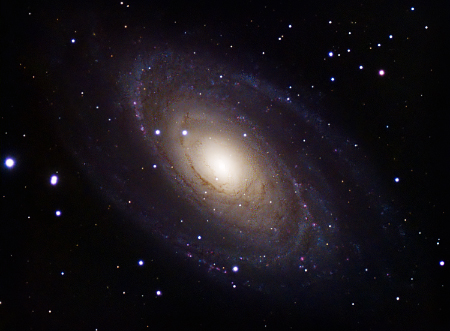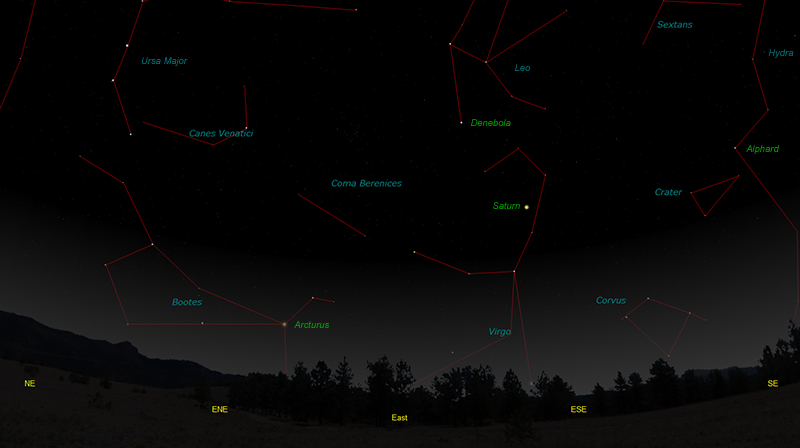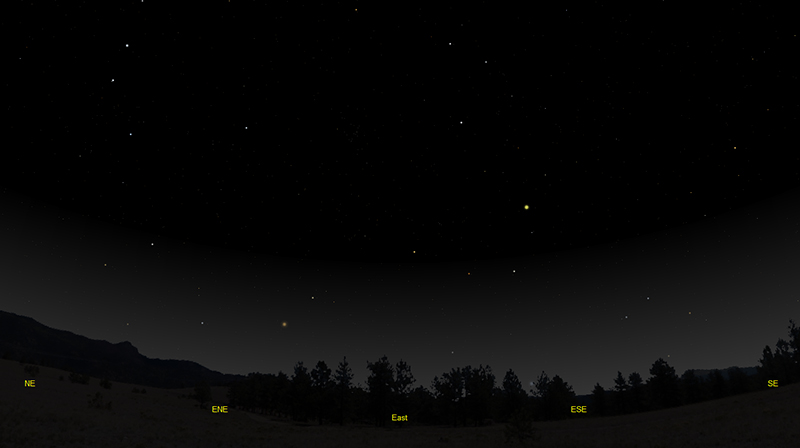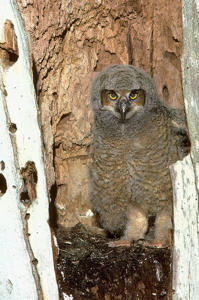The purpose of this feature is to give scout leaders, educators and naturalists an idea of some of the natural events coming up each month. We will try to cover a variety of natural events ranging from sky events to calling periods of amphibians, bird and mammal watching tips, prominent wildflowers and anything else that comes to mind. We will also note prominent constellations appearing over the eastern horizon at mid-evening each month for our area for those who would like to learn the constellations. If you have suggestions for other types of natural information you would like to see added to this calendar, let us know! Note: You can click on the hyperlinks to learn more about some of the featured items. To return to the Calendar, hit the "back" button on your browser, NOT the "back" button on the web page. All charts are available in a "printer friendly" mode, with black stars on a white background. Left clicking on each chart will take you to a printable black and white image. Please note that images on these pages are meant to be displayed at 100%. If your browser zooms into a higher magnification than that, the images may lose quality. Though we link book references to nationwide sources, we encourage you to support your local book store whenever possible.
Notes and Images From February 2010 On February evenings Ursa Major, the Great Bear, climbs high above the northeastern horizon. The constellation includes the "big dipper", one of the most recognizable asterisms in the sky. There are quite a few deep sky objects in and around the Ursa Major, and one of our favorites is the great spiral galaxy Messier 81. Poor weather conditions prevented astrophotography for much of the month. After I set up the telescope on February 18th, a Barn Owl flew overhead and seemed to bring us better luck. Messier 81 was discovered by Johann Bode. Observing from Berlin on New Year's Eve, 1774, he discovered two small "nebulae" in Ursa Major. Pierre Mechain independently discovered the same pair in August, 1779, and reported them to Charles Messier. Messier included them in his catalog of 1781 as Messier 81 and Messier 82. Messier 81 and Messier 82 had a close approach at some point in the distant past, and both show evidence of the encounter in their structure. In particular there is a dark linear feature below the nucleus of M81, visible in the image above, that is said to have resulted from the encounter. The two galaxies are now about 150,000 light-years apart. Messier 81 is about 12,000,000 light-years distant. You can learn a little about the galaxy from its colors. Older, predominantly yellow and red stars populate the nucleus, while younger, very hot blue stars dominate the outer regions of the galaxy. Dotting the spiral arms are patches of hydrogen gas which glow reddish pink. These areas are similar to the Orion Nebula in our own galaxy. Experienced observers in very dark sky locations have been able to see the galaxy with the naked eye. For a high-resolution version of the image and a binocular finder chart click here.
Sky Events for March 2010: The Vernal Equinox, marking the beginning of spring in the Northern Hemisphere, occurs on March 20th at 12:32pm CDT. Daylight savings time begins on March 14th. Evening Sky: Venus starts the month very low in the western sky after sunset. As the month goes on it will rise higher and higher into the twilight. It will be much easier to see by the end of the month. Mercury will also emerge into the evening twilight glow towards the end of the month. On March 15th look for it about 10 degrees above the western horizon 30 minutes after sunset. Mars is still in Cancer this month, high in the eastern sky at dusk. It is fading as the distance between Earth and Mars increases, and telescopic detail is harder to see. Saturn rises around 7:16pm Daylight savings time at mid-month. The rings are inclined only about 4 degrees to our line of sight. Morning Sky: Jupiter emerges into the morning twilight this month, but will be very hard to see in the dawn glow. All times noted in the Sky Events are for Franklin, Tennessee and are Central Standard Time before March 14th and Daylight Savings Time from March 14th onward. These times should be pretty close anywhere in the mid-state area.
Constellations: The views below show the sky looking east at 9:30pm CDT on March 15th. The first view shows the sky with the constellation outlines and names depicted. Star and planet names are in green. Constellation names are in blue. The second view shows the same scene without labels. The bright star Arcturus, in Bootes, the Herdsman, makes its appearance this month in the early evening sky, a sure sign that Spring is here. In the southeast, Virgo clears the horizon this month along with Corvus, the Crow. Saturn shines brightly in Virgo. The area of sky encompassing Leo, Virgo and Como Berenices marks the heart of the great Virgo cluster of galaxies.
On Learning the Constellations: We advise learning a few constellations each month, and then following them through the seasons. Once you associate a particular constellation coming over the eastern horizon at a certain time of year, you may start thinking about it like an old friend, looking forward to its arrival each season. The stars in the evening scene above, for instance, will always be in the same place relative to the horizon at the same time and date each March. Of course, the planets do move slowly through the constellations, but with practice you will learn to identify them from their appearance. In particular, learn the brightest stars (Like Arcturus and Denebola in the above scene looking east), for they will guide you to the fainter stars. Once you can locate the more prominent constellations, you can "branch out" to other constellations around them. It may take you a little while to get a sense of scale, to translate what you see on the computer screen or what you see on the page of a book to what you see in the sky. Look for patterns, like the stars of Corvus the Crow. The earth's rotation causes the constellations to appear to move across the sky just as the sun and the moon appear to do. If you go outside earlier than the time shown on the charts, the constellations will be lower to the eastern horizon. If you observe later, they will have climbed higher. As each season progresses, the earth's motion around the sun causes the constellations to appear a little farther towards the west each night for any given time of night. The westward motion of the constellations is equivalent to two hours per month. Recommended: Sky & Telescope's Pocket Star Atlas is beautiful, compact star atlas. It is destined to become a classic, and is a joy to use at the telescope. A good book to learn the constellations is Patterns in the Sky, by Hewitt-White. You may also want to check out at H. A. Rey's classic, The Stars, A New Way to See Them. For skywatching tips, an inexpensive good guide is Secrets of Stargazing, by Becky Ramotowski. A good general reference book on astronomy is the Peterson
Field Guide,
A Field Guide to the Stars and Planets, by Pasachoff. The book retails for around $14.00. Starry Night has several software programs for learning the night sky. Visit the Starry Night web site at www.starrynight.com for details.
Amphibians:
Southern Leopard Frogs, Upland Chorus Frogs and Spring Peepers continue to call in March. Listen on mild evenings for American Toads. In West Tennessee, Crawfish Frogs continue to give their loud snoring calls early in the month. At higher elevations, listen for Mountain Chorus Frogs. Towards the end of the month listen for Pickerel Frogs doing their "yeeooow" call. Remember that on mild nights you may find frogs and toads out foraging that you do not hear until later in the season. On warm days listen for early treefrogs, like Cope's Gray Treefrog, and for early Northern Cricket Frogs.
Birds:
This time of year is prime time to find owl nests. Since the leaves have not yet appeared on most trees, you can sometimes spot the old stick nests that the owls often use for nesting. Observe only at a distance and do not try to approach a nest, both for your own safety and to keep from flushing the owl off the eggs. The adult's absence, if it flushes, can allow the eggs to rapidly get too cold, and may doom the nest. Look and listen for the young Great Horned Owls. If you find a young owl on the ground, leave it there! Its parents will feed it on the ground. Well-meaning people sometimes take young owls they find on the ground to wildlife rehabilitation centers, thinking the young owls have been abandoned. This is not necessary, and it may prevent the owl from ever successfully living in the wild. Don't do it.
Recommended: The Sibley Guide to Birds, David Allen Sibley The Sibley Guide to Birds of Eastern North America, David Allen Sibley An inexpensive guide for beginners is the Golden Guide for Birds.
Archives (Remember to use the back button on your browser, NOT the back button on the web page!) Natural Calendar February 2010 Natural Calendar December 2009 Natural Calendar November 2009 Natural Calendar September 2009 Natural Calendar February 2009 Natural Calendar December 2008 Natural Calendar November 2008 Natural Calendar September 2008 Natural Calendar February 2008 Natural Calendar December 2007 Natural Calendar November 2007 Natural Calendar September 2007 Natural Calendar February 2007 Natural Calendar December 2006 Natural Calendar November 2006 Natural Calendar September 2006 Natural Calendar February 2006
Natural Calendar
December 2005
Natural Calendar
November 2005
Natural Calendar
September 2005
Natural Calendar
February 2005
Natural Calendar
December 2004
Natural Calendar
November 2004
Natural Calendar
September 2004
Natural Calendar
February 2004
Natural Calendar
December 2003
Natural Calendar
November 2003
Natural Calendar
September 2003 Natural Calendar February 2003 Natural Calendar December 2002 Natural Calendar November 2002 Nature Notes Archives: Nature Notes was a page we published in 2001 and 2002 containing our observations about everything from the northern lights display of November 2001 to frog and salamander egg masses.
Night scenes prepared with The Sky Professional from Software Bisque All images and recordings © 2010 Leaps |
|||||




